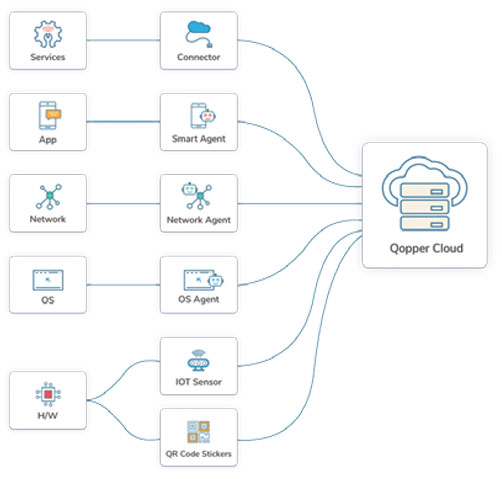THANK YOU FOR SUBSCRIBING
 Alok Bhanot, Founder & CEO
Alok Bhanot, Founder & CEOQopper is the brainchild of Alok Bhanot who dealt with these challenges during his tenure as the CTO of a major multi-national payments company with a large portfolio of payment devices. He observed that customers were constantly battling deployment issues arising from version inconsistencies, interoperability and compatibility issues across assets and vendors, frequent rollbacks of software updates and the resulting setbacks with looming deadlines. Beyond rollout, change and incident management in such a complex operational environment was also an ongoing challenge and kept the end to end system in a perpetual state of instability. Hence Qopper delivers operational insights, full stack visibility across all assets and incident management tools that leverage human-to-human(H2H) and human-to-machine(H2M) collaboration for efficient root cause analysis.
The lifecycle management of assets start with onboarding through the design interface, QopperForge, which can ingest asset inventory and configuration information from existing asset repositories. These assets are monitored using appropriate sensors, agents or connectors depending on the class of asset as depicted in the monitoring stack image below.
The telemetry data arising from this network of monitors is processed in real-time by a playbook to drive incident management processes and dashboards in QopperAlloy. The playbook is the brains of the platform and captures operational policies that can be customized, for e.g.: default incident severity level for refrigeration units are critical while it is major for all other assets. These policies can be very specific, for e.g. the default incident severity level for point-of-sale devices during store operations hours is critical and if not resolved within 30 minutes should be escalated to the service provider. The results of policy enforcement are used to drive real-time dashboards which are also available on the Qopper mobile app for staff members on the go. “This becomes very useful for a facility manager when they are looking at trends over an extended period and can check the most problematic devices in a particular location, or which specific location was more problematic than others” says Bhanot.
 A mid-sized grocery chain initially selected Qopper to address the false positive notifications and its resulting noise from a widely adopted network monitoring system. Through a combination of a customized playbook and Qopper’s network agent they realized operational efficiency gains immediately. They now use a Qopper powered TV console as their NOC. Store managers leverage the mobile app to get real-time incident notifications and to effectively collaborate with IT and Facilities using chat and video. “They continue to work with consistent interfaces, as they just keep extending the platform with newer integrations and products and their processes don’t need to change at all” states Bhanot.
A mid-sized grocery chain initially selected Qopper to address the false positive notifications and its resulting noise from a widely adopted network monitoring system. Through a combination of a customized playbook and Qopper’s network agent they realized operational efficiency gains immediately. They now use a Qopper powered TV console as their NOC. Store managers leverage the mobile app to get real-time incident notifications and to effectively collaborate with IT and Facilities using chat and video. “They continue to work with consistent interfaces, as they just keep extending the platform with newer integrations and products and their processes don’t need to change at all” states Bhanot.
Now that there exists a steady stream of asset operational data, the team at Qopper is evaluating AI and machine learning models to offer additional value-added services to transform operations and improve efficiency.
The telemetry data arising from this network of monitors is processed in real-time by a playbook to drive incident management processes and dashboards in QopperAlloy. The playbook is the brains of the platform and captures operational policies that can be customized, for e.g.: default incident severity level for refrigeration units are critical while it is major for all other assets. These policies can be very specific, for e.g. the default incident severity level for point-of-sale devices during store operations hours is critical and if not resolved within 30 minutes should be escalated to the service provider. The results of policy enforcement are used to drive real-time dashboards which are also available on the Qopper mobile app for staff members on the go. “This becomes very useful for a facility manager when they are looking at trends over an extended period and can check the most problematic devices in a particular location, or which specific location was more problematic than others” says Bhanot.
 A mid-sized grocery chain initially selected Qopper to address the false positive notifications and its resulting noise from a widely adopted network monitoring system. Through a combination of a customized playbook and Qopper’s network agent they realized operational efficiency gains immediately. They now use a Qopper powered TV console as their NOC. Store managers leverage the mobile app to get real-time incident notifications and to effectively collaborate with IT and Facilities using chat and video. “They continue to work with consistent interfaces, as they just keep extending the platform with newer integrations and products and their processes don’t need to change at all” states Bhanot.
A mid-sized grocery chain initially selected Qopper to address the false positive notifications and its resulting noise from a widely adopted network monitoring system. Through a combination of a customized playbook and Qopper’s network agent they realized operational efficiency gains immediately. They now use a Qopper powered TV console as their NOC. Store managers leverage the mobile app to get real-time incident notifications and to effectively collaborate with IT and Facilities using chat and video. “They continue to work with consistent interfaces, as they just keep extending the platform with newer integrations and products and their processes don’t need to change at all” states Bhanot. Now that there exists a steady stream of asset operational data, the team at Qopper is evaluating AI and machine learning models to offer additional value-added services to transform operations and improve efficiency.

I agree We use cookies on this website to enhance your user experience. By clicking any link on this page you are giving your consent for us to set cookies. More info













